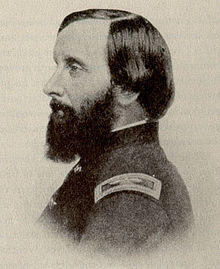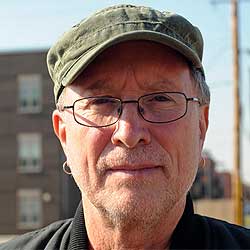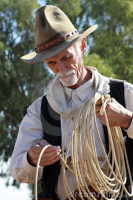
John Brown, 1859
In 1858 abolitionist/terrorist John Brown was appealing for funds for his terrorist activities. Even terrorists have to pay for the chaos they create. The subject of this article, Rev. Thomas Wentworth Higginson, noted, upon receiving Brown’s plea for funds that “I am always ready to invest money in treason, but at present have none to invest.” So, for Higginson, the treasonous intent was clearly there, even if they money to support it wasn’t.
Most who have studied our history seriously already know that, in his terrorist assault on the Federal armory at Harpers Ferry, Virginia, John Brown had the support, both moral and financial, of a group called The Secret Six. These men were very well-known and well connected Northeasterners (New England and New York) who were radical abolitionists (as opposed to common-sense abolitionists).
They wanted the institution of slavery gone immediately, if not sooner, no matter what the consequences of such a rash act were, and they were willing todo, or to delegate someone else to do, whatever that took, no matter how bloody that work might become or how many might be hurt. Their “noble” ends justified their means in their own eyes. They were very typical Yankee/Marxists whether they realized that or not.

Thomas Wentworth Higginson
One of the most bold among them in his insistence that “It’s my way or the highway” was our subject, Thomas Wentworth Higginson. Wikipedia has described him as “…an American Unitarian minister, author, abolitionist, and soldier. He was active in the American abolitionist movement during the 1840s and 1850s, identifying himself with disunion and militant abolitionism.” Disunion? Heavens! When the South sought disunion via legitimate secession that was supposed to be treasonous, or to be rebellion (it wasn’t). It seems, though, that Higginson’s form of disunion must have been okay because he was never castigated for it like the South was. Perhaps he was approaching it from the proper theological (Unitarian) perspective. To paraphrase–one man’s disunion may be another man’s dictatorship.
After the War of Northern Aggression was over Higginson devoted much of the remainder of his life to striving for the “rights” of slaves, women, and other “disenfranchised” groups. In other words, he hewed to the socialist line and agenda, as his later life will reveal. When he became the pastor of the Free Church in Worcester, Massachusetts in 1852 he supported abolition, labor rights, women’s rights, along with temperance.
 The group The Secret Six, of which Higginson was one, helped John Brown to raise both supplies and financial help for an intended slave revolt, to take place at Harpers Ferry, Virginia. Frankly, it was a terrible place to foment a slave revolt. It was in the hill country of western Virginia and there were just not all that many slaves in that region. Brown and whoever helped him couldn’t have picked a worse place, but then, who knows if such a poor choice was coincidence or something more?
The group The Secret Six, of which Higginson was one, helped John Brown to raise both supplies and financial help for an intended slave revolt, to take place at Harpers Ferry, Virginia. Frankly, it was a terrible place to foment a slave revolt. It was in the hill country of western Virginia and there were just not all that many slaves in that region. Brown and whoever helped him couldn’t have picked a worse place, but then, who knows if such a poor choice was coincidence or something more?
When Brown’s poorly orchestrated attempt failed and he was captured, Higginson even made plans to help him escape from custody, although the plans never panned out.
J. C. Furnas, in The Road to Harpers Ferry noted, on page 336 that “Higginson’s memoirs admitted that his boldness in rescuing slaves and backing Old Brown did not come wholly from moral conviction but from …intrinsic love of adventure…boyish desire for a stirring experience…”
After John Brown’s death, Higginson also planned to rescue those among Brown’s raiders who were still awaiting trial. He even went so far as to bring Jayhawker terrorist James Montgomery east from Kansas “to see what he could do as leader of a group of liberty-minded German exiles from the revolutions of 1848 whom Higginson had recruited.” So Higginson had recruited a batch of socialist Forty-Eighters, under Montgomery’s command, to try to break the remaining raiders out of jail. This shows that Rev. Higginson must have had contact with the socialists and Marxists that came to this country after their socialist revolts flopped in Europe. And his “recruiting” of James Montgomery is also enlightening. Montgomery was among the most unsavory of the Kansas Jayhawkers–an outright pillager and plunderer. Interesting that a Unitarian clergyman should be so well-acquainted with looters, thieves and socialists. Birds of a feather perhaps?
November 7, 2018
“Always Ready to Invest Money in Treason…” ~ Part Two
Rev. Higginson had credentials as both a radical abolitionist and a revolutionary (and in many instances there was little difference).
 Historian Otto Scott, in his book The Secret Six revealed about Higginson that “He wanted to be seen as a man of action: not as a clergyman. In May 1857, speaking to the American Anti-Slavery Convention in New York, he made his hopes clear. ‘The question of slavery is a stern and practical one. Give us the power and we can make a new Constitution…how is that power to be obtained? By politics? Never. By revolution, and that alone’.” That statement, plus his known association with Kansas looters and socialist Forty-Eighters has to give you some faint glimmering as to what Rev. Higginson was really all about. As a Unitarian, he was already a potential revolutionary and apostate, no matter how “civil-sounding” the media descriptions of him are. But don’t go away, folks, you ain’t seen nothin’ yet.
Historian Otto Scott, in his book The Secret Six revealed about Higginson that “He wanted to be seen as a man of action: not as a clergyman. In May 1857, speaking to the American Anti-Slavery Convention in New York, he made his hopes clear. ‘The question of slavery is a stern and practical one. Give us the power and we can make a new Constitution…how is that power to be obtained? By politics? Never. By revolution, and that alone’.” That statement, plus his known association with Kansas looters and socialist Forty-Eighters has to give you some faint glimmering as to what Rev. Higginson was really all about. As a Unitarian, he was already a potential revolutionary and apostate, no matter how “civil-sounding” the media descriptions of him are. But don’t go away, folks, you ain’t seen nothin’ yet.
Ann Braude, author of Radical Spirits has also identified Higginson as one, who, with many other abolitionists, was involved in Spiritualism. On page 73 of her book she has noted that: “Spiritualism preoccupied Garrisonians during the 1850s but elicited a wide range of responses. Many reformers believed in Spiritualism but rarely identified themselves with the movement, focusing their public activities first on abolition and second on women’s rights. This group included Garrison, Lucy Coleman, Elizabeth Buffam Chase, Betsy Mix Cowles, Thomas Wentworth Higginson…” Higginson said: “Undoubtedly the facts of Spiritualism are the most important yet launched upon the history of humanity,…But the philosophy of Spiritualism is yet to be born…”
Braude informed her readers that, for all this, “Higginson found time to deliver and publish two addresses endorsing Spiritualism.” Higginson must have felt it was pretty important if he took time and trouble to publish these.
As you research this history and begin to connect the dots, you find disturbing trends that show the connections between abolitionists, socialists, Unitarians, Spiritualists, and many in the Women’s Rights movement. Not good! Yet how many of our “history” books dealing with this period bother to alert their readers to any of these connections. Don’t all trip over each other holding up your various editions!
One thing you have to say for Higginson is that he was consistent in his beliefs–in gross error, but consistent. Or you could say he was “seldom right, but never in doubt.” He was a life-long leftist radical (yes, they did exist way back then). He lived from 1823 until 1911–lots of time to do lots of damage (and he surely did). Even in his old age he continued this trend. Guess he was, at that point, too old to do anything else.
In 1906 he joined with other leftist radicals Jack London and Upton Sinclair to found the Intercollegiate Socialist Society. This socialist organization for college students eventually evolved into the Student League for Industrial Democracy–which eventually morphed into the Students for a Democratic Society (SDS). Anyone remember this happy little group of bomb-throwers that was so very active in the (communist) “peace movement” of the 1960s? Some of them turned into those bomb-throwers with the Molotov cocktails, the ones that were so very willing to kill for peace.

William Ayres
One of the better known among this “peace-loving” assembly was one William Ayres. He was a leader of the SDS in 1968-69. He belonged to a faction of the SDS called “The Weathermen.” According to Wikipedia, “Ayers had previously been a roommate of Terry Robbins, a fellow militant who was killed in 1970 along with Ayers’ girlfriend, Oughton and one other member in the Greenwich Village townhouse explosion, while constructing anti-personnel bombs intended for a non-commissioned officer dance at Fort Dix, New Jersey…Later in 1969, Ayers participated in planting a bomb at a statue dedicated to police casualties in the 1886 Haymarket affair…The blast broke almost 100 windows and blew pieces of the statue onto the nearby Kennedy Expressway.”
This same William Ayers, just coincidentally, happened to be a close friend of the former occupant of the White House, Comrade Barack Obama.
If anyone ever tells you that past history has no bearing on what goes on today he is either naïve, dumb, or he sincerely hopes you are.
You can trace the radicalism of Ayers and his SDS bomb-throwing buddies all the way back through the predecessors of the SDS, right to the organization that Thomas Wentworth Higginson helped to found back in 1906. Here was a man, born in 1823, whose radicalism can be traced down through his spiritual grandchildren to our own day. Folks, please wake up and start to connect the dots!!!
Learn to ignore those who inform you that the past has no bearing on either the present or the future. As the man says “He who controls the past also controls the future.”
The Biblical admonition “study to show thyself approved…” is a true admonition. It applied to God’s Word, the Holy Bible, but it also applies to history and we have to become more aware of that, much more aware, than we presently are, especially if we are Christians.
November 9, 2018
 ~ The Author ~
~ The Author ~
Al Benson Jr. is the editor and publisher of “The Copperhead Chronicle“, a quarterly newsletter that presents history from a pro-Southern and Christian perspective. He has written for several publications over the years. His articles have appeared in “The National Educator,” “The Free Magnolia,” and the “Southern Patriot.” I addition to that he was the editor of, and wrote for, “The Christian Educator” for several years. In addition to The Copperhead Chronicles, Al also maintains Revised History.
He is currently a member of the Confederate Society of America and the Sons of Confederate Veterans, and has, in the past, been a member of the John Birch Society. He is the co-author, along with Walter D. Kennedy, of the book “Lincoln’s Marxists” and he has written for several Internet sites as well as authoring a series of booklets, with tests, dealing with the War of Northern Aggression, for home school students.
He and his wife now live in northern Louisiana.
Mr. Benson is a highly respected scholar and writer and has graciously allowed Metropolis Café to publish his works. We are proud to have his involvement with this project.
